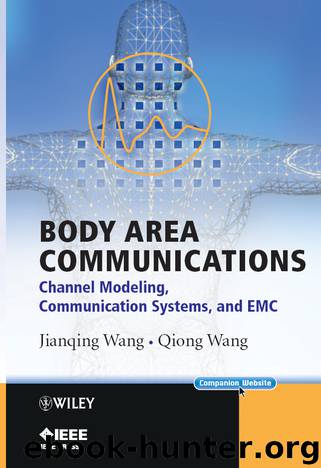Body Area Communications: Channel Modeling, Communication Systems, and EMC by Jianqing Wang Qiong Wang

Author:Jianqing Wang, Qiong Wang
Language: eng
Format: epub
Publisher: Wiley-IEEE Press
Published: 2012-10-21T16:00:00+00:00
Chapter 5
Modulation/Demodulation
5.1 Introduction
In order to transmit a digital signal over a body area communication band, the digital signal is often impressed onto a carrier signal. The corresponding process is called modulation in which the digital information signal varies one or more properties of the carrier signal, including amplitude, phase and its frequency. The inverse process of modulation is called demodulation where the original digital information is extracted from the modulated carrier signal. In this chapter, we will describe summarily the feasible modulation and demodulation schemes in body area communications. For various available frequency bands described in Chapter 1, different schemes will be covered. Moreover, based on the body area communication channel characteristics, improvements and simplifications on the receiver structure will also be introduced.
In digital modulation and demodulation, the carrier signal is typically a high frequency sinusoid waveform, while a pulse train may also be utilized in wideband communications. The digital signal may be either binary with two levels or M-ary with multiple levels where each level will represent a discrete pattern of information bits. The fundamental digital modulation methods include amplitude-shift keying (ASK), frequency-shift keying (FSK), and phase-shift keying (PSK). There are also various variations based on these three fundamental modulation schemes. Note that these modulation schemes are essentially narrow-band schemes in which the bandwidth of the modulated signal depends on the bandwidth of the baseband signal. These fundamental narrow-band schemes are well qualified for MICS band, ISM band or HBC band communication. In addition to the fundamental modulation methods, wideband schemes required in certain body area communication scenarios using UWB band will also be covered in this chapter. In fact, two typical UWB schemes, impulse radio UWB (IR-UWB) and multi-band orthogonal frequency-division multiplexing (MB-OFDM), will be presented in this chapter. For UWB communication, the commonly used receivers are based on the pulse energy detection or correlation demodulation with the template waveform. This still applies in body area UWB communications. However, as described in Chapters 2 and 4, the complicated transmission mechanisms in the body area will give rise to a multipath affected propagation channel so that a received signal may end up being the superimposition of several attenuated, delayed, time-varying and eventually distorted replicas of a transmitted signal. Given the body area multipath channel model characteristics derived in Chapter 4, RAKE reception comes in handy to counter the effects of multipath propagation, which could very well result in better communication performance in a multipath environment than in a “clean” environment. In addition, diversity reception can be applied at the receiver to improve the reception performance via multiple receivers/antennas as well as different polarizations.
In this chapter, the modulation schemes for digital shift keying as well as IR-UWB and MB-OFDM will be described first, followed by the corresponding demodulation schemes and error probability analysis. RAKE reception will be separately presented and the error probability with RAKE receiver in body area multipath channel will be given in detail. Finally, we will present the diversity reception application in the in-body communications where multiple
Download
This site does not store any files on its server. We only index and link to content provided by other sites. Please contact the content providers to delete copyright contents if any and email us, we'll remove relevant links or contents immediately.
Deep Learning with Python by François Chollet(14999)
The Mikado Method by Ola Ellnestam Daniel Brolund(12258)
Hello! Python by Anthony Briggs(12152)
OCA Java SE 8 Programmer I Certification Guide by Mala Gupta(11529)
Dependency Injection in .NET by Mark Seemann(11313)
A Developer's Guide to Building Resilient Cloud Applications with Azure by Hamida Rebai Trabelsi(10528)
Algorithms of the Intelligent Web by Haralambos Marmanis;Dmitry Babenko(10128)
The Well-Grounded Java Developer by Benjamin J. Evans Martijn Verburg(9781)
Grails in Action by Glen Smith Peter Ledbrook(9455)
Hit Refresh by Satya Nadella(9039)
Secrets of the JavaScript Ninja by John Resig Bear Bibeault(9007)
Sass and Compass in Action by Wynn Netherland Nathan Weizenbaum Chris Eppstein Brandon Mathis(9003)
The Kubernetes Operator Framework Book by Michael Dame(8473)
Test-Driven iOS Development with Swift 4 by Dominik Hauser(8424)
Exploring Deepfakes by Bryan Lyon and Matt Tora(8298)
Robo-Advisor with Python by Aki Ranin(8248)
Practical Computer Architecture with Python and ARM by Alan Clements(8224)
Implementing Enterprise Observability for Success by Manisha Agrawal and Karun Krishnannair(8193)
Building Low Latency Applications with C++ by Sourav Ghosh(8098)
